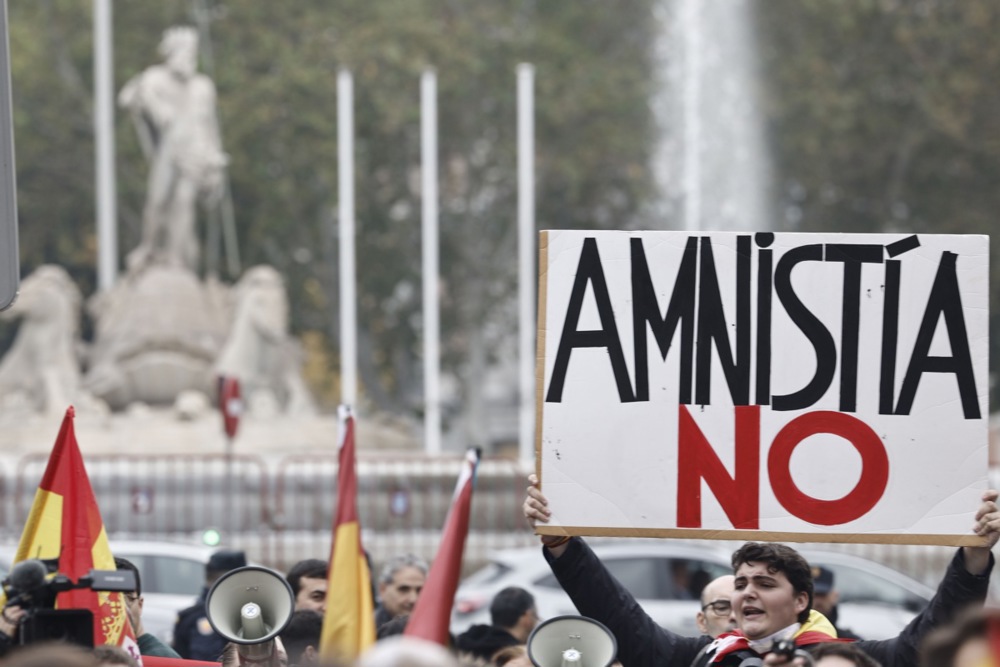The Spanish Ministry of the Interior registered more than 56,000 undocumented people entering Spain last year — an 82 per cent increase on the 31,000 seen in 2022.
While this figure remains below the all-time high of 64,000 seen in 2018, it nevertheless represents a trend of increasing uncontrolled immigration into Spanish territories.
Last year also proved to be the deadliest so far for migrants looking to enter Spain. Spanish aid organisation Caminando Fronteras (Walking Borders) said some “6,618 people lost their lives at the Euro-African Western Border, including 363 women and 384 children” throughout 2023.
Like elsewhere in Europe, most migrants travelling to the country do so in small boats, many of which are unfit to traverse the open ocean.
The main routes into Spain avoids the country’s mainland, with most arrivals attempting to gain entry via one of the country’s overseas territories.
The Canary Islands is one of the most popular destinations for would-be asylum seekers. An estimated 53,000 migrants arrived on the islands in 2023, many of whom were unaccompanied minors.
This migration wave has continued into 2024, with 7,270 migrants arriving on the island’s shores in January alone. In the first two weeks of February 2023, Spanish authorities had already rescued some 3,000 migrants.
The Civil Guard and the Spanish National Police are calling for more resources to defend the borders, while NGOs ask for increased humanitarian aid.
Others are calling for the government to put greater effort into securing the country’s borders.
“It is very easy to focus on the humanitarian dimension of the problem but let us not forget that States have the obligation to protect their territory,” Carlos Echeverría, the director of the Ceuta and Melilla Observatory, told Brussels Signal.
“Failing to protect it will not lead to equal opportunities for people.”
The number of “irregular” migrants arriving at Spain’s Canary Islands jumped by more than 1,000 per cent during January 2024 as compared with a year before, according to Spain’s interior ministry. https://t.co/1N0gDdmGaq
— Brussels Signal (@brusselssignal) February 12, 2024
The last time the islands saw such an influx of refugees was during the so-called “Canoe Crisis”. Occurring in 2006, the incident saw tens of thousands from North Africa and the Sahel arrive in the hope of seeking refuge from a number of crises plaguing the continent at the time.
Last year’s arrivals have blown this figure out of the water, with 67 per cent more migrants landing on the islands in 2023 compared to the 31,000 arrivals seen during the previous spike.
According to Walking Borders, this route is also one of the most dangerous ways illegal migrants travel to Spain, with the route now being favoured by would-be asylum seekers from Mauritania, Senegal and Gambia despite the risks.
On February 8, European Commission President Ursula von der Leyen visited Mauritania with Sánchez and offered the country more than €210 million in the hopes of curtailing departures.
Around 57,000 migrants entered Spain irregularly last year, almost double the 2022 number as arrivals on the Canary Islands in fragile boats from West Africa surged to record levels. https://t.co/rNnxqC4qOr
— Brussels Signal (@brusselssignal) January 4, 2024
Another route favoured by migrants is travelling to the cities of Ceuta and Melilla, with both cities being autonomous Spanish exclaves located on the northern coast of the African mainland.
In 2022, some 2,000 locals attempted to forcibly cross Melilla’s barbed-wire border fence. The incident resulted in clashes between the migrants and the border patrol forces of both Spain and Morocco.
“Ceuta and Melilla, and the rest of Spanish territories in North Africa belong to the European Union. They are part of its external borders,” Echeverría explained.
The academic added that, amid the current increase in migrant arrivals into Spain, a more “rigorous and realistic approach” was now needed to secure the border, in part due to some African countries working to weaponise the crisis as a way of gaining leverage over the EU.
He singled out Morocco as being one state engaging in such a “foreign policy”, accusing it of having “instrumentalised” mass migration for its own ends.
“We must not forget that Ceuta and Melilla are in the southern border not just of Spain, but of Europe,” he said. “Europe must pay more attention to them.”
“We continue to witness the use of hybrid strategies and unfriendly acts, which requires a vigilant attitude and a more demanding foreign policy,” according to Echeverría.
“With this Moroccan foreign policy, we will have guaranteed problems in the present and in the future,” the academic concluded.
More than 6,600 migrants died attempting to make their way to Spain by boat in 2023, almost three times the previous year, according to Spanish aid organisation Caminando Fronteras (Walking Borders). https://t.co/dtF9OS73mE
— Brussels Signal (@brusselssignal) January 11, 2024





